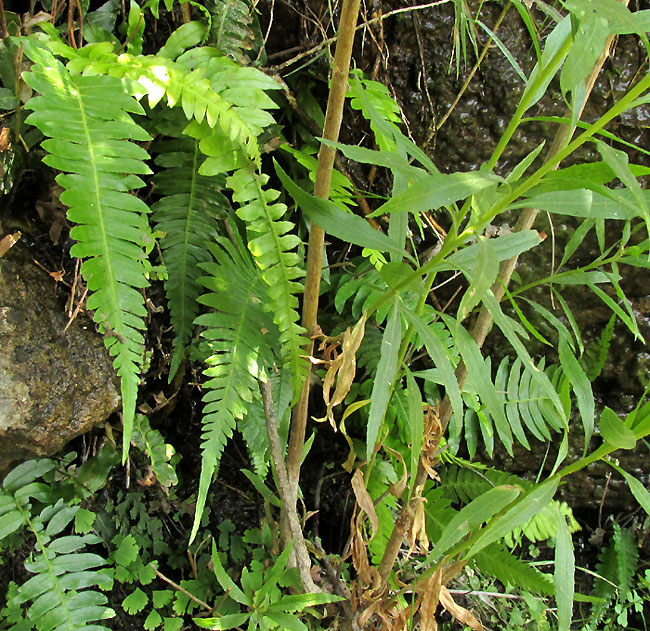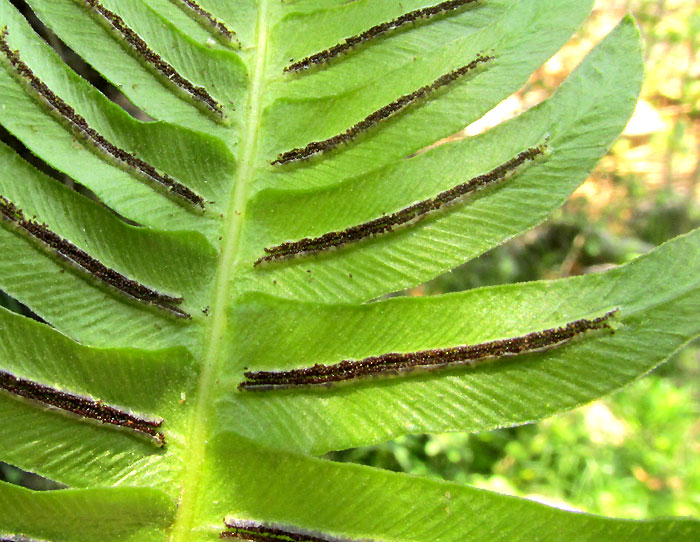Excerpts from Jim Conrad's
Naturalist Newsletter
entry dated May 21, 2022, notes from a camping trip among hills about 7kms ENE of Tequisquiapan, Querétaro state, MÉXICO
elevation about 2020m (6700 ft), near N20.57°, W99.85°
PALM FERN

Here at the end of an especially dry dry-season the landscape is mostly gray and brown, except in those rare spots at the bases of cliffs and the heads of canyons where spring water seeps to the surface. In such spots a small but lush and green oasis forms, where all through the day birds and other animals come to drink, and plant species turn up not found out in the sunbaked scrub. One of those species was the fern shown above, the one best open to view in the picture's upper left corner. Smaller ones emerge elsewhere amid non-fern plants, plus at the picture's lower left there's a maidenhair fern with green-confetti-like subdivisions.
This is a cluttered environment with many organisms competing for precious water. Note behind the plants the spongy, glistening layer of mingled algae, fungi, cyanobacteria and more coating the wet rock wall.
At first glance our fern is similar to many others, a pretty, graceful one but nondescript. However, on the frond's underside something surprising turns up:

This fern is at its peak of producing tiny, spherical, black, spore-filled sporangia, and its manner of presenting them is very unusual. Most fern species, unless their sporangia are arranged on special, different-looking structures, arrange their sporangia in individual small "fruit dots," or sori, on the frond's undersurface. Usually several sori appear on each frond subdivision, typically arranged in some systematic pattern, and each sorus displays a particular shape -- maybe straight, hooked or circular. Often each sorus has a papery, silvery, partial covering, the indusium.
In contrast, our fern frond presents a single very long arrangement composed of two huge sori with accompanying silvery indusia, extending along the midribs of each frond subdivision. Technically that's described as "sori borne on vascular commissures parallel to costae, 1 per side."
This structure deserves a closer look:

While those tiny, black sporangia are in view, it's interesting to remember that most fern sporangia bear inside them 64 spores, each spore carrying the genetic material needed for forming a new fern. Fern spores are small.
Being such a nonconformist, our fern is easily identified as what's often called the Palm Fern, BLECHNUM APPENDICULATUM. Despite its novel sori, in mountain forests and humid microclimates like ours, throughout the uplands of most of Mexico south through much of South America, Palms Ferns are fairly common. About 220 Blechnum species are recognized, mostly being tropical and South American.
One Palm Fern adaptation enabling such ecological success is displayed in our top photo: Most likely the various fronds looking like different individual Palm Ferns are actually clonal sprouts from far-spreading and branching stems creeping across the rock's surface. In certain parts of the world, such as Hawaii, Palm Ferns have become invasive, forming large, long persisting, clonal colonies which suppress native species.
That genus name Blechnum, sounding so coarse to English-speakers, is from the classical Greek Blechnon, which was simply an ancient name for ferns in general.